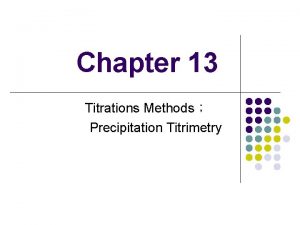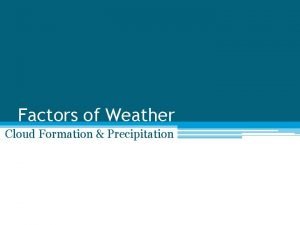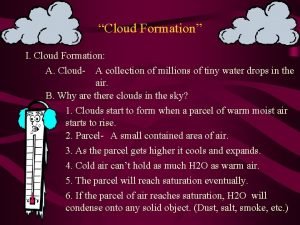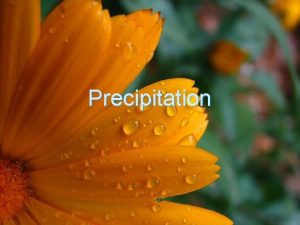Lecture 4 Precipitation 1 Definition Formation Cloud formation





- Slides: 5

Lecture 4 Precipitation (1) • Definition • Formation • Cloud formation • Terms to remember

Precipitation Definition Precipitation includes all processes that the Earth’s surface receives water from the atmosphere: rainfall, drizzle, dew and mist in liquid forms, and snow and hail in solid forms Formation Precipitation is formed in the atmosphere by condensation and coalescence of water droplets or ice crystals

Terms to Remember (1) 1. Water vapour: a gaseous water molecule 2. Vapour pressure: partial pressure of the atmosphere caused by the gaseous water in the atmosphere. Pressure is the force exerted on a unit surface in a unit time. The unit is Pascal (Nm-2 s-1, where the force unit N is Newton. 1 N=1 kg m-1 s-2), or mb (=100 Pascal) 3. Saturated vapour pressure: the maximum amount of water vapour that the air can hold at a certain temperature. It is a function of temperature.

Terms to Remember (2) 4. Dew point: for a given amount of water vapour in the air, the temperature can be decreased to a point where the air becomes saturated. This point is the dew point 5. Temperature lapse rate: the rate at which the air temperature decreases with height 6. Environmental lapse rate (ELR): the temperature lapse rate in the environment surrounding an ascending or descending air parcel. It is about 6 C /km 7. Adiabatic process: air parcel ascending or descending without exchange of heat with the environment, i. e. , no mixing between the air parcel and the ambient air

Terms to Remember (3) 8. Dry adiabatic lapse rate (DALR): the decrease of air temperature with height in the ascending air parcel without water condensation. It is about 9. 8 C /km 9. Saturated adiabatic lapse rate (SALR): the decrease of air temperature with height in the ascending air parcel with water condensation. As the condensation release heat, SALR is smaller than DALR 10. Condensation level: height at which the temperature of an ascending air parcel decreases to the dew point (the air parcel become saturated). Clouds form above this level 11. Unstable air: ELR>SALP, or ELR>DALR









